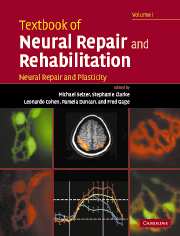Book contents
- Frontmatter
- Contents
- Contents (contents of Volume II)
- Preface
- Contributors (contributors of Volume I)
- Contributors (contributors of Volume II)
- Neural repair and rehabilitation: an introduction
- Section A Neural plasticity
- Section A1 Cellular and molecular mechanisms of neural plasticity
- Section A2 Functional plasticity in CNS system
- 6 Plasticity of mature and developing somatosensory systems
- 7 Activity-dependent plasticity in the intact spinal cord
- 8 Plasticity of cerebral motor functions: implications for repair and rehabilitation
- 9 Plasticity in visual connections: retinal ganglion cell axonal development and regeneration
- 10 Plasticity in auditory functions
- 11 Cross-modal plasticity in sensory systems
- 12 Attentional modulation of cortical plasticity
- Section A3 Plasticity after injury to the CNS
- Section B1 Neural repair
- Section B2 Determinants of regeneration in the injured nervous system
- Section B3 Promotion of regeneration in the injured nervous system
- Section B4 Translational research: application to human neural injury
- Index
10 - Plasticity in auditory functions
from Section A2 - Functional plasticity in CNS system
Published online by Cambridge University Press: 05 March 2012
- Frontmatter
- Contents
- Contents (contents of Volume II)
- Preface
- Contributors (contributors of Volume I)
- Contributors (contributors of Volume II)
- Neural repair and rehabilitation: an introduction
- Section A Neural plasticity
- Section A1 Cellular and molecular mechanisms of neural plasticity
- Section A2 Functional plasticity in CNS system
- 6 Plasticity of mature and developing somatosensory systems
- 7 Activity-dependent plasticity in the intact spinal cord
- 8 Plasticity of cerebral motor functions: implications for repair and rehabilitation
- 9 Plasticity in visual connections: retinal ganglion cell axonal development and regeneration
- 10 Plasticity in auditory functions
- 11 Cross-modal plasticity in sensory systems
- 12 Attentional modulation of cortical plasticity
- Section A3 Plasticity after injury to the CNS
- Section B1 Neural repair
- Section B2 Determinants of regeneration in the injured nervous system
- Section B3 Promotion of regeneration in the injured nervous system
- Section B4 Translational research: application to human neural injury
- Index
Summary
Summary
This chapter covers plasticity in the central auditory system, most notably in the auditory cortex, from a variety of viewpoints. Neuroanatomical and neurophysiological studies in animals as well as behavioral and functional imaging studies in humans will be considered. Plasticity in the auditory system will be compared to plasticity in other sensory systems, and the reorganization of the central auditory system during early blindness and deafness will be discussed. The findings from research in auditory cortical plasticity have important implications for the design of auditory prostheses, such as cochlear implants, in the deaf, and visual prostheses in the blind using nonvisual modalities. They also further the understanding and treatment of common ailments, including hearing loss and tinnitus in an aging population as well as the effects of otitis media in young children.
Introduction
Auditory cortex plays a crucial role in higher perceptual and cognitive functions, including those of speech and music, and in the processing of auditory space. Cortical plasticity, as in other sensory systems, is used to fine-tune these higher functions and plays an important role in reorganization after early injury. Auditory cortical plasticity can be demonstrated after lesions of the cochlea and appears to participate in generating tinnitus. Early musical training leads to an expansion of auditory cortex representing complex harmonic sounds. Similarly, the early phonetic environment has a strong influence on speech development and, presumably, cortical organization of speech.
Keywords
- Type
- Chapter
- Information
- Textbook of Neural Repair and Rehabilitation , pp. 162 - 179Publisher: Cambridge University PressPrint publication year: 2006
- 1
- Cited by



